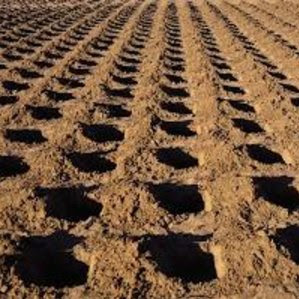The power of Tassa
Today's post is connected to the previous one talking about African indigenous knowledge. I will be expanding on the topic of Tassa/Zaï because this approach is being used in many African countries and is initiated by the local farmers and communities. It is estimated that there will be an 8-22% yield loss of millet and sorghum by 2050 (Kimaru-Muchai, Ngetich, Baaru and Mucheru-Muna, 2020) because of frequent droughts, which threatens food security in rainfed agriculture in Africa. Tassa/Zaï is one of many examples how African knowledge is used in agriculture.
Tassa (in Niger) or Zaï (in Burkina Faso) is a time tested indigenous technique that is low cost and can be implemented everywhere. It is used to maximise the use of seasonal rainfall, consists of digging holes 200-300mm in diameter, 150-200 mm deep, and covering the bottoms with manure (World Bank, 2012). This technique is mostly used to grow millet or sorghum. It was implemented in 1989 when IFAD-funded SWC sent 13 farmers in Burkina Faso (Yatenga Region) to learn about Tassa/Zaï and other conservation practices (Kabore and Reji, 2004). When the farmers retired they started to try these techniques on their own fields and came out with impressive results that caught the attention of other farmers, who also started to use the approach. In 1990, a drought year, fields approached with the Tassa/Zaï technique were the only ones producing a harvest, which created even more popularity around the approach, and between 1992-1994 the prices of degraded land had doubled because of the success of Tassa/Zaï (Kabore and Reji, 2004). Today, the average yield of millet is around 480 kg/ha with Tassa/Zaï approach and only 130 kg/ha without it (World Bank, 2012). The approach is done by the farmers themselves with no other help and has provided families with not only food but also money.
 |
| Tassa/Zai |
 |
| Tassa/Zai |
The only disadvantage of the Tassa/Zaï approach is that it requires ~300h of labour (Maiga, 2013). This is difficult to implement for farmers with not many family members. To eliminate this problem, NGOs are looking at the use of animal and motorised traction (Maiga, 2013) to support all farmers in adopting this approach.
 |
| Animal traction |
In many parts of Africa not only Tassa/Zaï, but other agricultural approaches have been demonstrated, but in some places, the adaptation has been poor. This has been influenced by education levels. According to Kimaru-Muchai, Ngetich, Baaru, and Mucheru-Muna (2020), a study showed that education levels have influenced if farmers will adopt water harvesting techniques. Education is important because, with access to it, there is access to information, which creates awareness. Farmers with no education at all are less likely to adopt new techniques. In this case, it is important for governmental and non-governmental organisations to invest in training and create awareness on Tassa/Zaï or any other farming techniques that will help more farmers to have productive yields.
Tassa/Zaï shows that the approach of African knowledge is successful and involves the input of the local farmers and communities. With a little help from governments or NGOs to support education programs on Tassa/Zaï or any other African knowledge-based agricultural approach, more small-scale farmers can transform their land, produce more yield, and be economically more secure. Many places in Africa could and already have alleviated water stress in agriculture and enhanced soil fertility, which will help countries come out of the poverty trap.

I have never hear of Tassa before but this blog post highlights the important role it plays. Excellent synthesis!
ReplyDelete